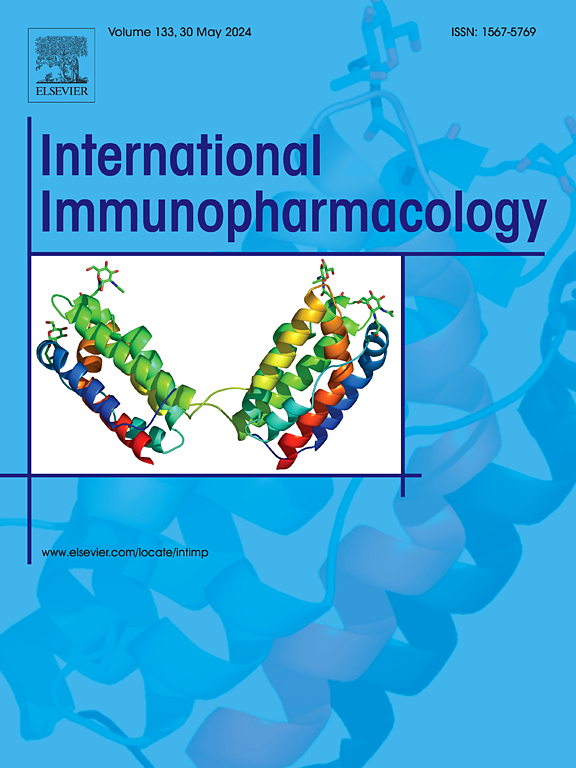ythdf1通过与β-catenin/TCF4信号相互作用介导线粒体功能障碍和过敏性气道炎症
IF 4.7
2区 医学
Q2 IMMUNOLOGY
引用次数: 0
摘要
虽然n6 -甲基腺苷(m6A)修饰及其解读蛋白YTHDF1与过敏性气道炎症有关,但它们在tdi诱导的类固醇不敏感哮喘中的作用尚不清楚。β-连环蛋白信号对哮喘患者气道炎症和线粒体功能至关重要。在这项研究中,我们在tdi诱导的哮喘模型(TDI-AM)中研究了β-catenin/TCF4信号通路与m6a依赖性调节之间的相互作用。方法用TDI或屋尘螨(HDM)致敏小鼠建立哮喘模型。小鼠分别给予YHTDF1 m6A修饰抑制剂(Tegaserod)、β-catenin/TCF4信号抑制剂(LF3)和线粒体稳定药物SS-31三乙酸酯。将含TDI的人血清白蛋白引入人支气管上皮细胞和巨噬细胞模拟哮喘模型。结果TDI-AM中thdf1表达上调。在TDI-AM中使用浓度为1 mg/kg的Tegaserod进行预处理,可以显著减轻tdi诱导的气道高反应性、气道炎症、气道重塑和线粒体功能障碍,而使用浓度为5 mg/kg的Tegaserod进行预处理则表现出相反的效果。上述变化在hdm诱导的哮喘小鼠中得到证实。JASPAR软件预测β-catenin信号下游转录因子TCF4与YTHDF1启动子区结合,提示TCF4与YTHDF1可能存在相互作用。用LF3阻断β-catenin/TCF4信号传导,可在很大程度上抑制气道炎症、线粒体功能障碍和TDI-AM中YTHDF1的表达。LF3能显著抑制YTHDF1蛋白的表达。经三乙酸SS-31治疗后,tdi诱导的气道炎症和线粒体功能障碍均明显减少。结论ythdf1通过与β-catenin/TCF4信号相互作用介导线粒体功能障碍和变应性气道炎症。本文章由计算机程序翻译,如有差异,请以英文原文为准。
YTHDF1-mediated mitochondrial dysfunction and allergic airway inflammation by interaction with β-catenin/TCF4 signaling
Background
Although N6-methyladenosine (m6A) modification and its reader protein YTHDF1 have been implicated in allergic airway inflammation, their roles in TDI-induced steroid-insensitive asthma remains unclear. β-catenin signaling is vital for airway inflammation and mitochondrial function in asthma. In this study, we investigated the interplay between β-catenin/TCF4 signaling and m6A-dependent regulation in a TDI-induced asthma model (TDI-AM).
Method
Mice were sensitized and challenged with TDI or house dust mite (HDM) to establish asthma models. Mice were administered the YHTDF1 m6A modification inhibitor (Tegaserod), the β-catenin/TCF4 signaling inhibitor (LF3), and the mitochondrial stabilizing drug SS-31 triacetate. Human serum albumin-containing TDI was introduced to human bronchial epithelial cells and macrophages to mimic the asthma model.
Result
YTHDF1 was upregulated in the TDI-AM. Pretreatment with a 1 mg/kg concentration of Tegaserod in TDI-AM revealed significant alleviation of TDI-induced airway hyperresponsiveness, airway inflammation, airway remodeling, and mitochondrial dysfunction, but pretreatment with 5 mg/kg concentration of Tegaserod showed the opposite effect. The changes above corroborated in HDM-induced asthmatic mice. JASPAR software predicted the β-catenin signaling downstream transcription factor TCF4 combined with YTHDF1 promoter region, suggesting a possible interaction between TCF4 and YTHDF1. Blockade of β-catenin/TCF4 signaling with LF3 largely inhibited airway inflammation, mitochondrial dysfunction, and the expression of YTHDF1 in the TDI-AM. Treatment with LF3 can significantly inhibit the expression of YTHDF1 protein. The TDI-induced airway inflammation, as well as mitochondrial dysfunction, were both significantly decreased after treatment with SS-31 triacetate.
Conclusion
YTHDF1-mediated mitochondrial dysfunction and allergic airway inflammation by interaction with β-catenin/TCF4 signaling.
求助全文
通过发布文献求助,成功后即可免费获取论文全文。
去求助
来源期刊
CiteScore
8.40
自引率
3.60%
发文量
935
审稿时长
53 days
期刊介绍:
International Immunopharmacology is the primary vehicle for the publication of original research papers pertinent to the overlapping areas of immunology, pharmacology, cytokine biology, immunotherapy, immunopathology and immunotoxicology. Review articles that encompass these subjects are also welcome.
The subject material appropriate for submission includes:
• Clinical studies employing immunotherapy of any type including the use of: bacterial and chemical agents; thymic hormones, interferon, lymphokines, etc., in transplantation and diseases such as cancer, immunodeficiency, chronic infection and allergic, inflammatory or autoimmune disorders.
• Studies on the mechanisms of action of these agents for specific parameters of immune competence as well as the overall clinical state.
• Pre-clinical animal studies and in vitro studies on mechanisms of action with immunopotentiators, immunomodulators, immunoadjuvants and other pharmacological agents active on cells participating in immune or allergic responses.
• Pharmacological compounds, microbial products and toxicological agents that affect the lymphoid system, and their mechanisms of action.
• Agents that activate genes or modify transcription and translation within the immune response.
• Substances activated, generated, or released through immunologic or related pathways that are pharmacologically active.
• Production, function and regulation of cytokines and their receptors.
• Classical pharmacological studies on the effects of chemokines and bioactive factors released during immunological reactions.

 求助内容:
求助内容: 应助结果提醒方式:
应助结果提醒方式:


